Earlier this week we slept in our converted camping van for the first time… with our two small dogs… in the driveway. Given it was the first time, we decided to stay close to home should anything major go awry. That decision turned out to be a good idea!
We purchased the 2004, semi-converted Chevy van only six weeks ago. I’ve spent four of those weeks tearing out and redesigning the interior to accommodate our foray into part-time #vanlife during our semi-retirement years. The intent is to visit our children and grandchildren. They are now scattered about, living all over the western United States. Because their homes are filled with children, there are no longer any guest rooms for us. A wonderful trade-off!
We had stayed at hotels, but didn’t like the associated costs nor having to board our dogs when we traveled. The van is to become our “hotel room on wheels” so we can visit our family (guesting in their driveways), bring our dogs, stay as suited for everyone’s schedule, and not spend a fortune in the process.
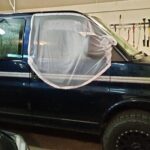
In our younger days, my husband and I did remote tent camping, car camping, and even trailer camping. However, due to where we live now, an older, reliable, converted camper van seems our best option. It will also be my daily around-town vehicle. The biggest requirement was that it had to fit in the garage. And it does. Just.
After a week of removing what was already in the van, then discussing desirable camping features with my husband, I spent three weeks re-designing the internal layout. I insisted on a “no-build build” idea so everything can be changed if we need the vehicle for something other than camping.
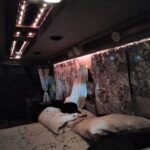
I did most of the installation, which included sewing, shopping, crafting, arranging, installing, and set-up. I selected everything from a sofa bed to fairy lights to a “Luggable Loo” toilet. My husband provided his input, the money, and muscle, too. We packed everything we might need (and more) for a vacation into the 70 square feet. Still, we decided a test was wise to be sure we didn’t forget anything.
While we had packed the van during the day with snacks, clothes, water, etc., our evening test began well after sunset. That was our first mistake. We did consider that, if something was missing – even though I’d made multiple lists – we could just dash inside the house and collect it.
Lesson 1: Set up camp in the daylight.
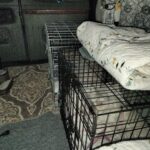
After loading up the dogs in their crates and providing them with water, our next task was to connect the long extension cord to an outlet in the garage. Although I had been the one to initially store the cord in the van, my husband was the one to get it out and unwind it. Unfortunately, confusion ensued about how it had been wound to begin with. It was difficult to unwind in the dark driveway. And why were those small bungee cords wrapped around it? We turned on the garage lights to illuminate the cord mess into a workable solution.
Lesson 2: Set up camp in the daylight.
Next, the extension cord was snaked from the garage through an open window into the van to power a surge-suppressor, multi-outlet unit for the computer and monitor (for livestreaming movies). That was the moment we discovered the outlet unit had not yet been stowed. Another trip to the house.
Lesson 3: Test systems completely and keep parts together. Set up camp in the daylight.
Once the electrical cord and outlet unit was turned on, we powered up our computer-related devices. Two small portable fans were already buzzing – one with its own battery and directed at our bed; the other USB-style fan, plugged into an external, fully-charged battery power supply, which gave the dogs a cooling breeze. Both fans – combined with the mosquito-netted, open front door windows – provided adequate air flow throughout the van. It also helped that the temperature was only in the mid-70’s.
Wait! No Wi-Fi? We had assumed we’d be able to connect to our home’s internet account from the driveway. It had worked before when we were parked in the garage, but now, less than 20 feet from our previous test spot, and we had no connection. We tried several times to connect on various devices. No luck. At least we had remembered to bring books and magazines for our nighttime ritual.
Lesson 4: Have internet HotSpot capability – OR – bring reading materials or external DVD/CD drives for movies. Set up camp in the daylight.
Although we had meant to keep the house off-limits for this experiment, that rule had already been broken several times. I ended up walking the dogs through the house (on their leashes) to the backyard for their final pee of the evening. I then marched them back to the van, locking doors and shutting off lights behind me. While I was walking the dogs, my husband shut down the devices and put them away. When the garage door came down, the reality of sleeping in our van in the driveway became really REAL.
Dogs locked in their crates? Check. Van doors locked? Yes. Phones and keys nearby? Of course. Water bottles handy? Indeed. Toilet set-up for late-night routines? Absolutely!
I had earlier given my husband a tour of where all the touch-lights were located and how to use them. The privacy curtain for the toilet area was also in place. All other window coverings insulated us from the outside world.
Lesson 5: Take your time; be methodical. Set up camp in the daylight.
I crawled across the sofa bed to my cozy, corner spot and collapsed into the pillows. As my husband read his paperback crime novel with the aid of a small solar-powered light propped on his chest, my eyes explored the van interior. My mind reviewed all the plans we had discussed and the hot days of working in the garage to achieve this moment. I’m happy with the aesthetic results.
What was disappointing, however, was the sofa bed. So hard! Neither of us slept well after the first hour. We’ll soon add some kind of topper to soften it. The bed is narrow for two people, but we can deal with that. We were both warm without coverings most of the night. Only in the pre-dawn hours did we feel the need for the quilt.
Also during the night, I became keenly aware of the slant of our driveway. While it’s not much of an incline, my body seemed to slide down the mattress toward the street. I repeatedly pulled myself up toward the pillows. Apparently this wasn’t an issue for my snoring husband.
Lesson 6: Find a level place to park. Set up camp in the daylight.
The 6:10 a.m. alarm was louder in the van than it had ever been in the bedroom. I threw on clothes and made another run to the backyard with the dogs. As I tried to get the dogs back into the van, rabid barking ensued. They were surprised by a neighbor out for her morning walk… across the street. Their loud vocal response made clear their feelings about such an intrusion in their corner of the neighborhood.
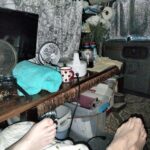
Thanks to the handy electrical cord and outlet unit, we heated the water in the electric kettle and enjoyed pour-over coffee. The ice in the small cooler chest chilled the coffee creamers loaded up the night before. Strong coffee never tasted so good. While there was enough hot water to make oatmeal, we decided on having breakfast later after we “got home.”
Our overnight test proved to be a success. We survived! My husband retracted the electrical cord from the window. We both shared in storing it in a new way. I hopped into the driver’s seat to move the van back into its place in the garage. Once the garage door was secure, we released the hounds, cleaned up the van, and fixed a welcome hot breakfast.
Lesson 7: Be flexible. Plan for what you can. Enjoy the adventure. And set up camp in the daylight.
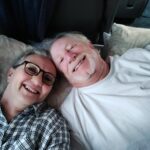
Our future excursions will be more than 20 feet from our back door. We’re excited, but nervous, to “get on the road.” We’ve never had a vacation without a timeframe or urgency to return. It’ll be interesting to see how Life shows up in our journeys.